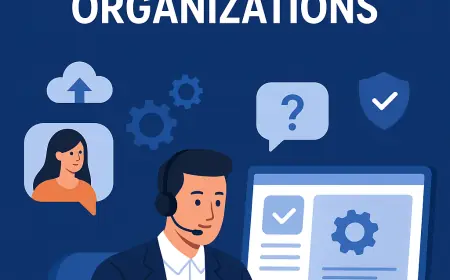How Secure Is a Generative AI Voice Bot Solution for Enterprises?
As enterprises increasingly adopt generative AI voice bot solutions for customer support and internal operations, security becomes a top priority. This blog explores the key security features built into modern generative AI voice bots, including data encryption, user authentication, compliance with industry regulations (like GDPR and HIPAA), and safeguards against misuse or data breaches.

In today’s AI-driven landscape, generative AI voice bot solutions are becoming an integral part of enterprise operations—from handling customer service calls to automating internal processes. While their benefits in scalability, efficiency, and customer experience are well documented, there remains one critical question for any business leader: “How secure is a generative AI voice bot solution for enterprises?”
Given the sensitive nature of the data processed through these bots—ranging from customer details and transaction histories to healthcare records and financial information—security is not just important, it’s non-negotiable.
In this blog, we’ll explore the key security features, risks, and best practices associated with deploying generative AI voice bots in enterprise environments.
1. End-to-End Data Encryption
Generative AI voice bots handle large volumes of real-time voice data. To protect this information, end-to-end encryption is typically employed. This includes:
-
In-transit encryption (TLS/SSL): Safeguards data as it moves between users, the voice bot, and backend systems.
-
At-rest encryption: Ensures data stored on servers or cloud platforms remains secure and unreadable to unauthorized users.
Enterprises should ensure their voice bot provider complies with industry-standard encryption protocols.
2. Secure Data Storage and Access Controls
Enterprise-grade voice bot solutions store data in secure, encrypted databases, often hosted on reputable cloud platforms like AWS, Azure, or Google Cloud. These platforms offer:
-
Role-based access controls (RBAC): To ensure only authorized personnel can access specific types of data.
-
Audit trails: To track who accessed what data and when—essential for accountability and compliance.
Access to the voice bot’s data, training models, and transcripts is tightly regulated to prevent insider threats and breaches.
3. Compliance with Industry Regulations
Security also means compliance. Enterprises often operate in regulated environments—financial services, healthcare, telecom—and must ensure their technology stack aligns with legal frameworks such as:
-
GDPR (General Data Protection Regulation)
-
HIPAA (Health Insurance Portability and Accountability Act)
-
CCPA (California Consumer Privacy Act)
-
PCI-DSS (Payment Card Industry Data Security Standard)
A secure generative AI voice bot solution will offer built-in features and certifications that help enterprises meet these regulations, including data anonymization, retention policies, and consent mechanisms.
4. Secure API Integrations
Generative AI voice bots often integrate with CRMs, ERPs, payment gateways, and other enterprise software. These integrations must be secured through token-based authentication, OAuth, and IP whitelisting to ensure safe communication between systems.
Vulnerable or unsecured APIs could be an easy target for attackers, making API security a critical component of the bot’s overall architecture.
5. Real-Time Threat Detection and Monitoring
Many modern voice bot platforms come equipped with AI-powered threat detection systems. These systems monitor activity for anomalies such as:
-
Unusual access patterns
-
Suspicious API usage
-
Excessive request volumes
-
Attempts to extract data from conversation logs
Alerts and automated responses can be triggered in real time, allowing security teams to take immediate action.
6. User Authentication and Identity Verification
Security isn’t just about the backend—it’s also about who’s on the other end of the line. Generative AI voice bots can incorporate biometric voice authentication, multi-factor authentication (MFA), or even voice pattern recognition to validate user identity.
This prevents unauthorized access and fraud, particularly in high-risk interactions like banking, insurance claims, or personal data updates.
7. Model Security and Data Leakage Prevention
Generative AI models learn from the data they’re trained on, which poses a potential risk of data leakage if not properly managed. To prevent sensitive information from inadvertently appearing in outputs, responsible AI providers:
-
Train models using anonymized data
-
Employ data masking techniques
-
Conduct regular audits and model testing to detect leaks or hallucinations
Enterprises should seek solutions that offer transparency in how training data is handled and how models are fine-tuned.
8. Vendor Transparency and Incident Response Plans
A truly secure AI solution provider will be transparent about its security protocols and offer:
-
Service-Level Agreements (SLAs) covering data protection
-
Incident response plans for breaches or downtime
-
Regular third-party security audits and certifications
Choosing a vendor with a strong security posture and public trust record is a critical part of the equation.
Risks Still Remain — But They’re Manageable
No system is 100% immune to attacks. The risks of data interception, model exploitation, or unauthorized access exist, just like with any digital platform. However, with the right architecture, protocols, and governance, these risks can be minimized to acceptable levels.
Conclusion: Trust Comes with Design and Diligence
So, how secure is a generative AI voice bot solution for enterprises?
Very secure— when implemented with best practices and backed by a reliable technology partner. From encryption and compliance to access controls and threat detection, today's voice bot platforms are built with security at their core.
For enterprises planning to integrate AI voice technology, the key is due diligence: ask the hard questions, review certifications, and collaborate closely with your IT and legal teams. A secure generative AI voice bot not only protects your business—it also builds trust with your customers, which is invaluable in a digital-first world.
What's Your Reaction?
 Like
0
Like
0
 Dislike
0
Dislike
0
 Love
0
Love
0
 Funny
0
Funny
0
 Angry
0
Angry
0
 Sad
0
Sad
0
 Wow
0
Wow
0












































